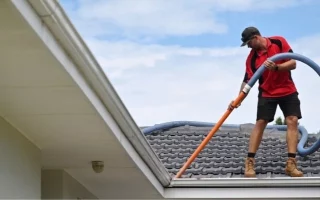A sagging roof is unsightly and a sign of potential structural issues that need prompt attention. Several factors can contribute to the sagging of a roof, from age-related wear and tear to improper construction practices. In this comprehensive guide, we’ll delve into the common causes of a sagging roof, the implications of this problem, and the solutions available to rectify it, ensuring your home’s structural integrity and safety.
Age and Weathering:

One of the primary reasons for a sagging roof is the natural ageing process and prolonged exposure to harsh weather conditions. Over time, the roof’s materials, such as rafters, trusses, and decking, may deteriorate due to moisture infiltration, UV exposure, temperature fluctuations, and the effects of wind and precipitation. This gradual degradation weakens the structural integrity of the roof system, leading to sagging and deflection over time.
Poor Roof Design or Construction:
Sometimes, a sagging roof can be attributed to design flaws or construction errors during installation. Insufficient structural support, inadequate bracing, improper installation of roof components, and shortcuts taken during construction can compromise the stability and load-bearing capacity of the roof, resulting in sagging or unevenness. Poor artistry or substandard materials used in construction can exacerbate these issues and accelerate the onset of roof sagging.
Overloaded Roof:
Excessive weight or loads on the roof can cause it to sag under the strain. Accumulation of heavy snow, ice, or debris on the roof during winter months, the installation of multiple layers of roofing materials without proper reinforcement, or the addition of heavy rooftop equipment such as HVAC units or solar panels can overload the roof structure and lead to sagging or deflection. Properly distributing weight and conducting regular inspections to remove debris and snow buildup can help mitigate this risk.
Water Damage and Moisture Intrusion:
Water damage and moisture intrusion are common culprits behind roof sagging, particularly in regions prone to heavy rainfall, humidity, or plumbing leaks. Persistent exposure to water infiltration can weaken the roof’s structural components, including rafters, trusses, and sheathing, causing them to deteriorate, rot, or warp over time. This weakening of the roof structure compromises its ability to support the weight of the roofing materials and external loads, resulting in sagging or deformation.
Termite or Pest Infestation:
Infestation by termites, wood-boring beetles, or other pests can undermine the roof’s structural integrity by feeding on wooden components such as rafters, trusses, and decking. As these pests tunnel through the wood, they weaken its strength and load-bearing capacity, leading to sagging, bowing, or collapse in severe cases. Regular inspections and proactive pest control measures are essential for identifying and addressing infestations before they cause significant damage to the roof structure.
Implications of a Sagging Roof:
- Compromised Structural Stability: A sagging roof compromises the structural stability of the entire building, increasing the risk of collapse or structural failure, particularly during extreme weather events or seismic activity.
- Water Damage and Mold Growth: Sagging roofs are prone to water pooling and moisture accumulation, leading to water damage, rot, and mould growth within the roof cavity and interior spaces. This can compromise indoor air quality and pose health hazards to occupants.
- Reduced Energy Efficiency: A sagging roof may compromise the effectiveness of insulation and ventilation systems, leading to energy loss, temperature fluctuations, and increased utility costs for heating and cooling.
- Aesthetic Concerns: Sagging roofs detract from a property’s visual appeal and curb appeal, diminishing its market value and desirability among potential buyers or tenants.
Solutions for Rectifying a Sagging Roof:
- Professional Inspection: Begin by hiring a qualified roofing contractor or structural engineer to conduct a thorough inspection of the roof and assess the extent of the sagging, identify underlying causes, and recommend appropriate remedial measures.
- Structural Repairs: Depending on the nature and severity of the damage, structural repairs may be necessary to reinforce or replace damaged rafters, trusses, or decking. This may involve sistering new lumber to existing rafters, strengthening connections, or replacing deteriorated components.
- Moisture Mitigation: Address any sources of water infiltration or moisture intrusion, such as roof leaks, plumbing issues, or inadequate ventilation, to prevent further deterioration of the roof structure and mitigate the risk of mould growth and water damage.
- Roof Replacement: In cases where the sagging is caused by extensive damage or deterioration, roof replacement may be the most practical solution. Install a new roof system with proper structural support, quality materials, and professional installation to ensure long-term durability and performance.
- Pest Control: If pest infestation is identified as a contributing factor, implement appropriate pest control measures to eradicate the infestation and prevent future damage to the roof structure. This may involve treating affected areas with insecticides, sealing entry points, and implementing preventive measures to deter pests.
- Load Reduction: If the sagging is attributed to excessive weight or loads on the roof, reduce the load by removing heavy debris, snow, or equipment or redistributing weight to minimise stress on the roof structure.
- Regular Maintenance: Implement a proactive maintenance program to monitor the roof’s condition, address minor issues promptly, and prevent sagging and structural damage through routine inspections, cleaning, and upkeep.




